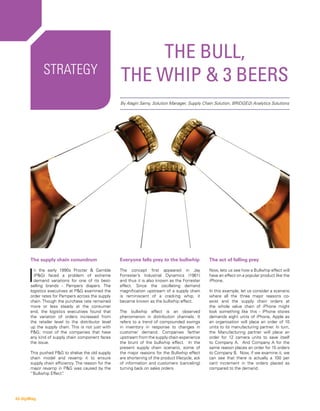digimag-july15
- 1. Strategy The Bull, the Whip & 3 Beers The supply chain conundrum I n the early 1990s Procter & Gamble (P&G) faced a problem of extreme demand variations for one of its best- selling brands - Pampers diapers. The logistics executives at P&G examined the order rates for Pampers across the supply chain. Though the purchase rate remained more or less steady at the consumer end, the logistics executives found that the variation of orders increased from the retailer level to the distributor level up the supply chain. This is not just with P&G; most of the companies that have any kind of supply chain component faces the issue. This pushed P&G to shelve the old supply chain model and revamp it to ensure supply chain efficiency. The reason for the major revamp in P&G was caused by the âBullwhip Effectâ. Everyone falls prey to the bullwhip The concept first appeared in Jay Forresterâs Industrial Dynamics (1961) and thus it is also known as the Forrester effect. Since the oscillating demand magnification upstream of a supply chain is reminiscent of a cracking whip, it became known as the bullwhip effect. The bullwhip effect is an observed phenomenon in distribution channels. It refers to a trend of compounded swings in inventory in response to changes in customer demand. Companies farther upstream from the supply chain experience the brunt of the bullwhip effect. In the present supply chain scenario, some of the major reasons for the Bullwhip effect are shortening of the product lifecycle, ack of information and customers (canceling) turning back on sales orders. By Alagiri Samy, Solution Manager, Supply Chain Solution, BRIDGEi2i Analytics Solutions The act of falling prey Now, lets us see how a Bullwhip effect will have an effect on a popular product like the iPhone. In this example, let us consider a scenario where all the three major reasons co- exist and the supply chain orders at the whole value chain of iPhone might look something like this - iPhone stores demands eight units of iPhone, Apple as an organisation will place an order of 10 units to its manufacturing partner. In turn, the Manufacturing partner will place an order for 12 camera units to save itself to Company A. And Company A for the same reason places an order for 15 orders to Company B. Now, if we examine it, we can see that there is actually a 100 per cent increment in the orders placed as compared to the demand. 43 digiMag
- 2. This is surprisingly a common scenario and easy to visualise but this is analytically a complex problem to solve. The resort to the 100 per cent higher order problem which has a cascading effects in the whole supply chain process is Analytics. In other words, Analytics can help in Lead-time reduction and accurately forecasting large demand volatility across the supply chain and this can reduce the bullwhip effect at each node. The Beer Game Since the 1960âs, industry believes that Bullwhip can be solved by not âdistorting information along the supply chainâ. But now, with time, the realisation has become stronger and deeper. Today, the industry believes that the identified solution can be provided by data driven decision approach. And moreover, solution will have high impact if a prescribed order pattern is provided at each node in the whole supply chain. This was more a theory until BRIDGEi2i Analytics Solutions was able to prove it in the Supplier Summit of Hewlett Packard (HP). The conference had all the suppliers of HP in the same board room. The task at hand was to prove the use of prescriptive analytics by improvising the âBeer Gameâ that was developed by MIT Sloan University back in 1961 to showcase the importance of communication. In the earlier version of Beer Game, candidates enact a four-stage supply chain. The task is to produce and deliver units of beer: the factory produces and the other three stages deliver the beer units until it reaches the customer at the end of the chain. The modified Beer Game The aim of the players is rather simple: each of the four groups has to fulfil incoming orders of beer by placing orders with the next upstream party. Communication and collaboration are not allowed between supply chain stages, so players invariably create the so-called bullwhip effect. Now, in order to showcase the importance of Prescribed Analytics we created the improvised Beer Game and two additional teams were created as a part of it. That is, other than the âNormal Beer Gameâ team and there was âAssisted Beer Gameâ team and âPrescribed Beer Gameâ team as well. The âNormal Beer Gameâ team had no analytics to drive decisions. The âAssisted Beer Gameâ team had an end customer demand forecast and the âPrescribed Beer Gameâ players had a prescribed order pattern for each node. The game started with the assumptions of inventory holding cost at $0.5 per unit and backorder (backlog) cost at $1 per unit.The operation was carried out for 20 iterations and the results were measured. Solution to the conundrum At the end of 20 iterations, results favoured the âPrescribed Beer Gameâ over the others. Findings of the simulation are below. Teams with prescribed analytics: ⢠Placed least amount of orders ⢠Had least amount of backorders and inventory ⢠Had the least cost of doing business In real numbers, it was identified that âNormal Beer Gameâ team with no forward looking view had spent $1,259. Assisted team with a demand forecast shared across the supply chain had spent $995 and prescribed team which had emerged as winner with predictive and operational insights spent $698 which was 45 per cent lower than âNormalâ and 35 per cent lower than the âAssistedâ teams. This proves that Predictive Analytics can help in overcoming the bullwhip effect. Most of the time, Bullwhip causes the manufacturers to sell off the inventories at a throwaway price by cutting on the margin to avoid a complete loss scenario. And therefore, next time whenever you purchase something during the Thanksgiving, just remember that one of the reasons for the low cost could be âBullwhipâ effect and you might not get it for the same price if it is solved. About the Author Solution Manager for Supply Chain Solution forBRIDGEi2iAnalyticsSolutions.Consults Fortune 500 global firms across industries to monetise value from Analytics by analysing information, deriving actionable insights and delivering sustained impact through operationalisation of Analytics. Former Editor in chief for MAARS India. Recognised as one of the top 180 bloggers in the field of Big Data & Analytics by Data Science Central. 45 digiMag

